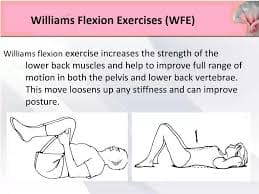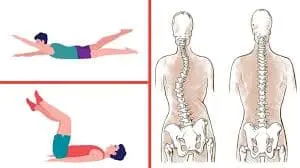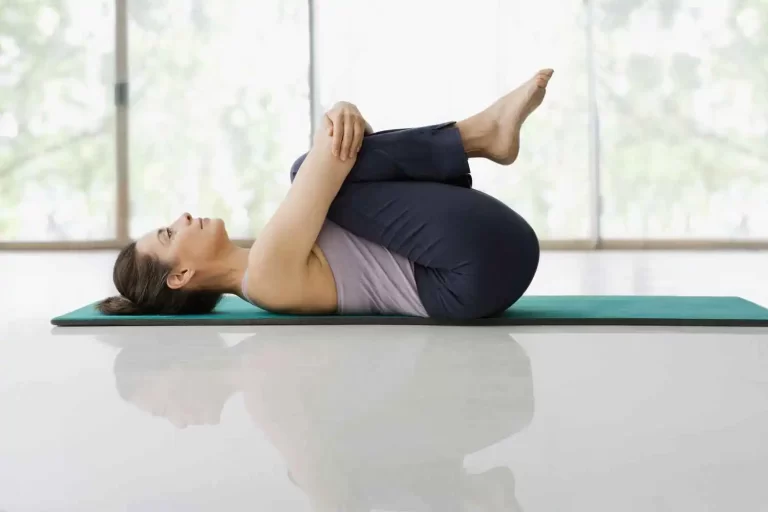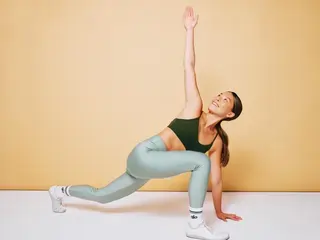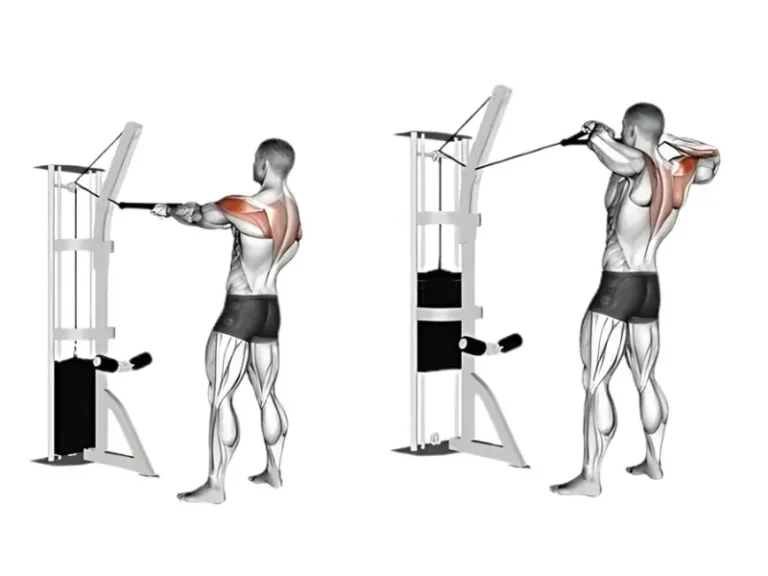15 Best Stretching Exercises For Shoulder
Introduction:
Shoulder stretching exercises help improve flexibility, reduce stiffness, and maintain a healthy range of motion. These stretches are beneficial for relieving tension, preventing injuries, and supporting recovery from shoulder pain or tightness caused by poor posture, overuse, or inactivity.
Common problems include shoulder stiffness and soreness, particularly for people who work lengthy desk jobs, do repetitive tasks, or participate in physically demanding activities. Stretching Exercises For the Shoulder can help you stay flexible, maintain good posture, increase your range of motion, and avoid injuries.
Perform these easy exercises three to six times weekly to reduce shoulder pain. As you gain strength and flexibility, progressively extend the time of your program from a 10-minute start.
When performing these exercises, concentrate on letting go of any tension in your shoulders and any other areas where you feel constricted.
Benefits of Stretching Exercises:
In addition to improving flexibility, shoulder stretches also improve posture, joint health, pain management, and even lessen the risk of injury.
The main advantages of shoulder stretching exercises are given below:
Supports Recovery and Rehabilitation
Stretching with control and progression is beneficial for shoulder issues.
- Promotes the regeneration of tissue and healing
- Restores joint mobility and function.
- Reduces stiffness and the development of scar tissue over time.
Promotes the shoulders’ range of motion
Since the shoulder is one of the body’s most mobile joints, it is also at risk for injury and stiffness.
- Keeps the tendons and muscles flexible.
- Allows for more mobility when doing daily tasks (e.g., reaching behind your back, overhead).
- Supports athletes’ or active people’s functional mobility
Reduces Tension in the Neck and Shoulders
Shoulder muscular tightness can result from repetitive motions, prolonged sitting, or stress.
- Reduces rotator cuff, deltoids, and trapezius muscular stiffness
- Makes more blood flow to tense or worn-out muscles.
- Encourages relaxation and may even lessen headaches caused by tense muscles.
Lowers the Chance of Injury
Restrictions in range of motion or tight shoulder muscles might cause tension and compensations.
- Reduces the risk of muscular strains or tears by relaxing tense muscles.
- Prevents rotator cuff injuries or shoulder impingement.
- Maintains the natural balance of muscles around the shoulder joint.
Improves Posture
Tight chest muscles and rounded shoulders are common results of bad posture, particularly from desk or phone use.
- Allows the chest and shoulders to open up.
- Supports in realigning your upper spine and shoulder blades.
- Lowers the possibility of postural abnormalities that cause pain in the neck and upper back.
Encourages Circulation and Joint Lubrication
- Encourages the synthesis of synovial fluid, which lubricates the upper arm.
- Increases the flow of blood and nutrients to connective tissues and muscles.
- Supports the long-term health of joints
Enhances Athletic Performance
Weightlifters, tennis players, and swimmers are examples of athletes who require strong, flexible shoulders because they utilize their upper bodies.
- Increases range of motion when performing motions particular to a sport.
- Helps preserve muscular flexibility for explosive movements
- Lessens muscle stiffness following intense workouts.
Encourages Mind-Body Awareness
Stretching regularly helps you move and feel better.
- Promotes proper body awareness and movement patterns
- Decreases anxiety and promotes mental calm when combined with breathing
- Increases your awareness of any shoulder imbalances or abnormalities
Stretching Exercises For The Shoulder:
Doorway stretch
- To begin, stand in a doorway.
- Maintaining a 90-degree angle between your arms and elbows.
- Put your palms against the door frame’s sides and take a step forward with your right foot.
- Put your core into action and bend forward.
- Take a few seconds to hold this position.
- Then return to your neutral position.
- Then relax.
- Repeat these exercises 5 to 10 times.
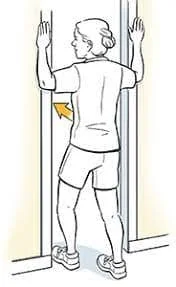
Cross-body stretch
- Start by standing up straight.
- Cross one arm over your chest.
- With your other hand, grasp the arm across your body by its outer forearm.
- For greater stretch, push that arm into your body.
- Hold this position for a few seconds.
- Then return to your neutral position.
- Then relax.
- Repeat these exercises 5 to 10 times.
- On the opposite arm, repeat.
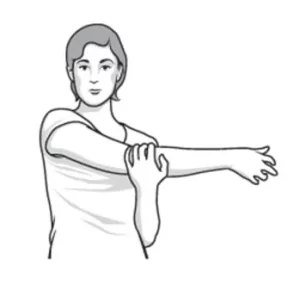
Child’s Pose
- On the floor, kneel.
- Sit on your heels, touch your big toes together, and then spread your knees apart by almost the same width as your hips.
- After exhaling, fold forward and place your body between your thighs.
- Hands should be facing the front of the mat.
- Hold this position for a few seconds.
- Then return to your neutral position.
- Then relax.
- Repeat these exercises 5 to 10 times.
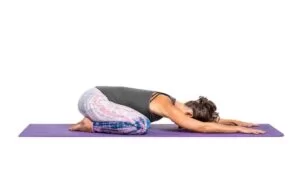
Triceps stretch
- Start with a standing position.
- Stretch your left arm straight up above your head.
- To place your hand between your shoulder blades behind your head, bend your left elbow.
- To make your left hand push farther down, gently draw the elbow across your back with your right hand.
- Hold this position for a few seconds.
- Then return to your neutral position.
- Then relax.
- Repeat these exercises 5 to 10 times.
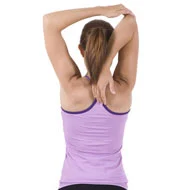
Thread the needle
- Place yourself on the floor in a tabletop position.
- Underneath your body, between your right wrist and right knee, extend your left arm.
- Move your head left side and shoulder gently in the direction of the floor.
- Your hips will slightly droop towards your heels.
- Let your right hand remain in its current position.
- Now, slowly raise your left arm into the air while keeping your head and eyes on it.
- Hold this position for a few seconds.
- Then return to your neutral position.
- Then relax.
- Repeat these exercises 5 to 10 times.
- Repeat on the opposite side.
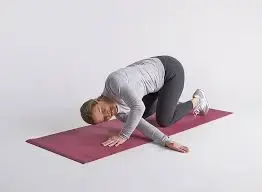
Quadruped Thoracic Rotation Stretch
- Get on your knees on a mat to start.
- Make sure the elbow of your right hand is pointed out from behind your head.
- Let your body follow as you take a breath and bend your right elbow down toward your left arm.
- Look at your elbow as you exhale and twist it up and out, opening your chest to the right.
- Avoid swaying from side to side and maintain a square hip position.
- Hold this position for a few seconds.
- Then return to your neutral position.
- Then relax.
- Repeat these exercises 5 to 10 times.
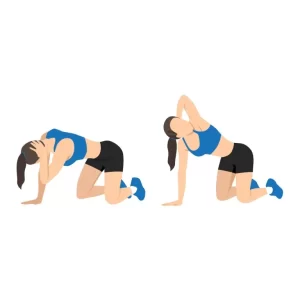
Open Books
- Start by resting on your back on the ground.
- Your hands should be behind your hips, with the fingers pointing to your feet.
- Maintaining your hands in place to support your weight, slowly lean back.
- Raise your legs off the floor and pull them up to your chest as you lean back.
- Hold this position for a few seconds.
- Then return to your neutral position.
- Then relax.
- Repeat these exercises 5 to 10 times.
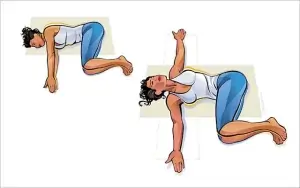
Eagle arm stretch
- Start with a standing position.
- Place both arms shoulder-high in the air.
- Your right elbow should stack on top of your left as you cross your right arm over your left.
- Point your forearms upward by bending both elbows.
- Continue encircling your arms until the palms contact or try putting the backs of your hands together.
- Raise the elbows a little above the chest.
- Gradually pull the arms forward to experience the back, shoulders, and upper back stretched.
- Hold this position for a few seconds.
- Then return to your neutral position.
- Then relax.
- Repeat these exercises 5 to 10 times.
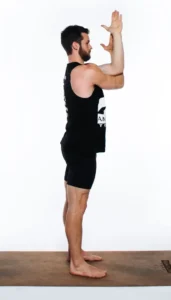
Sleeper stretch
- Place your shoulder below you while lying on the side that is affected.
- A pillow can be placed beneath your head.
- Extend your elbow from your shoulder straight.
- With your fingers pointing up at the ceiling, bend your arm at the elbow.
- Maintain this L position with your arm bent.
- Your forearm should be pushed down towards the floor with your other hand.
- Apply as much pressure as is comfortable.
- Hold this position for a few seconds.
- Then return to your neutral position.
- Then relax.
- Repeat these exercises 5 to 10 times.
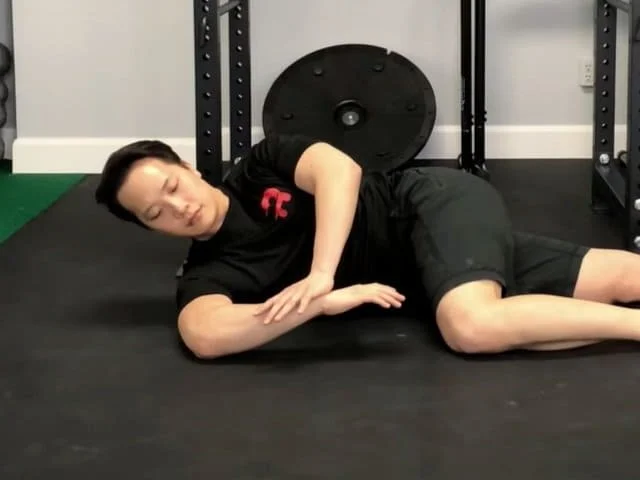
Cross-body arm swings
- Position your feet hip-width apart.
- Taking a breath, raise your arms to your sides while pressing your shoulder blades together.
- Release your breath and slowly move your arms closer to one another.
- Both arms should remain straight when you cross the right arm beneath the left.
- Breathe in and squeeze the shoulder blades together as you swing your arms back out to the sides.
- After exhaling, swing your arms back towards one another gently.
- Keeping both arms straight, cross the left arm beneath the right arm the next time.
- Then return to your neutral position.
- Then relax.
- Repeat these exercises 5 to 10 times.

Reverse shoulder stretch
- Your feet should be shoulder-width apart.
- Your arms by your sides.
- Put your hands behind your back after that.
- Your hands should be held back and towards the ceiling.
- Maintain a straight posture while opening your chest.
- Hold this position for a few seconds.
- Then return to your neutral position.
- Then relax.
- Repeat these exercises 5 to 10 times.
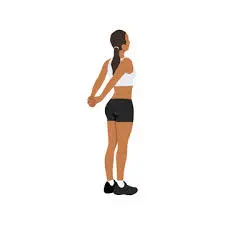
Downward Facing Dog
- Get down on your knees on the floor to begin.
- Make an inverted V form by extending your legs and curling your toes while raising your hips.
- Your weight should be properly distributed across your hands.
- Maintain a firm grasp with your fingertips.
- Continue moving your inner heels nearer to the mat as you try for stronger, upright legs.
- Hold this position for a few seconds.
- Then return to your neutral position.
- Then relax.
- Repeat these exercises 5 to 10 times.
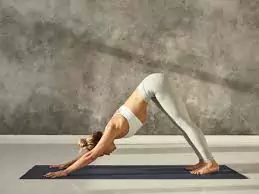
Table and wall slides
- Face a counter or table while sitting.
- Under the hand holding the shoulder that has to be stretched, place a towel, cloth, or slider.
- Put your hand comfortably on the slider with your palm pointing down.
- Slide your hand forward slowly while bending at the hips to keep up with the motion.
- While maintaining a relaxed neck, stretch your arm as far overhead as is comfortable.
- You should feel a slight stretch through the front of the shoulder and chest.
- Hold this position for a few seconds.
- Then return to your neutral position.
- Then relax.
- Repeat these exercises 5 to 10 times.
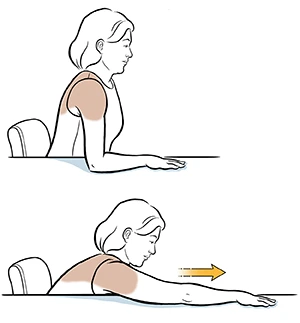
Scapular retractions
- Sit or stand upright and keep your arms at your sides.
- Maintain a straight spine and an active core.
- Squeeze your shoulder blades together gradually.
- For a few seconds, hold this contraction.
- Let your shoulders return to neutral by releasing gradually.
- Then return to your neutral position.
- Then relax.
- Repeat these exercises 5 to 10 times.
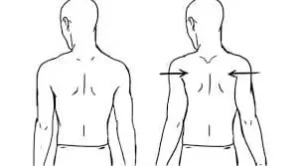
Chest expansion
- Start with a standing position.
- Place your arms behind your body and hold the end of an exercise band or towel in each hand.
- As you gently draw your shoulder blades together, raise your chest.
- Arms should be straight and raised as far behind you as is comfortable.
- Look up a little or straight ahead.
- You should feel as though your shoulders and chest are stretched.
- Keep your core active and your neck relaxed.
- Hold this position for a few seconds.
- Then return to your neutral position.
- Then relax.
- Repeat these exercises 5 to 10 times.
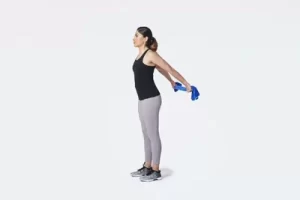
What precautions need to be taken when exercising?
Shoulder stretches are essential for managing flexibility, lowering stress, and avoiding injuries, particularly for older persons, athletes, and desk workers. On the other hand, improper stretching may worsen injuries, cause joint problems, or strain muscles.
Start with warming up.
- Don’t stretch chilly muscles.
- Before static stretching, engage in light aerobic or shoulder mobility exercises (such as shoulder rolls or arm circles) for three to five minutes.
Pay Attention to Proper Posture
- Maintain a neutral posture and avoid hunching forward or arching your back.
- Stretch your shoulders and use your core to keep your body stable.
Hold stretches without pushing them.
- For 15 to 30 seconds, hold each stretch.
- Avoid putting your shoulder in an uncomfortable or awkward posture.
Don’t Overstretch
- Go for tension rather than pain when stretching.
- Excessive pushing can cause ligament or muscle strain, particularly in the shoulder, a sensitive and complex joint.
Inhale Regularly
- Holding your breath creates unnecessary strain.
- Throughout the stretch, take calm, even breaths to help your muscles relax.
Do Not Extend Injured Shoulders
- A physical therapist or doctor should be consulted first if you have frozen shoulder, impingement, or rotator cuff issues.
It’s Important to Have Equality
- If one shoulder feels stiff, equally stretch the other.
- By doing this, imbalances can be prevented.
Stop if you’re in pain.
- It is OK to feel tight or uncomfortable, but not to have persistent or intense pain.
- An underlying injury or overstretching may be the cause of pain.
When did you quit working out?
When You Experience Sudden or Sharp Pain
- Pain is your body’s warning signal.
- It’s normal to feel a little tight or pulled during a stretch.
- However, stop right away if you get radiating, stabbing, or acute pain.
If You’re Swelling or Inflamed
- Inflamed tissues might get worse when stretched.
If Physical Activity Eventually Makes Symptoms Worse
- That means the stretch might not be suitable.
- Regular stretching should be stopped and the practice reevaluated if you notice that your range of motion is getting lessened, that you experience more pain after each session, and that you are losing your strength or coordination.
If You’re Not Stretching Correctly
- An injury may result from poor form.
If You Hear Painful Clicking or Popping
- Joint noise may be normal, but sound-related pain is a warning sign.
- Pain and clicking, grinding, or popping noises may be signs of A labral tear and joint instability.
When You’re Overworked or Fatigued
- Muscle fatigue increases the risk of injury.
- When your muscles are tired or painful from sports or strength training, overstretching can raise your risk of strains and delay the healing of your muscles.
Summary:
Shoulder stretches are easy yet effective ways to keep your joints healthy, reduce stress, and increase your range of motion. Incorporating these exercises into your routine can have a big impact, regardless of whether you’re an athlete, an office worker, or someone who sometimes gets shoulder pain.
Even though shoulder pain is frequent, it is preventable and treatable. You can treat shoulder pain on your own by using natural therapies. You can help stop the pain from returning by doing exercises and treatments even after you feel better.
Only stretch to the extent that it feels comfortable on that particular day. Avoid overexerting yourself, and stop the exercises if you feel pain that is more than just slight pain. If any of your medical conditions could be affected by exercise, consult your doctor before beginning any kind of program.
FAQ:
How frequently should I stretch my shoulders?
Stretching your shoulders three to five times a week is ideal. It’s ideal to stretch every day, especially if you have bad posture or stiff shoulders. The duration of sessions may vary from five to fifteen minutes, based on your needs and objectives.
Can shoulder pain be alleviated by stretching the shoulders?
Yes, stretching can help relieve mild to severe shoulder pain caused by overuse, tight muscles, or bad posture. See your doctor if the pain doesn’t go away or gets worse while you stretch.
Is it possible to improve posture using shoulder stretches?
Indeed. Shoulder stretches ease forward shoulder bending, balance out tense muscles, and open up the chest. Stretching, especially for those who spend a lot of time sitting, can greatly improve upper body posture when combined with strengthening activities.
Is it common to feel tight or uncomfortable after stretching your shoulders?
It’s normal to feel a little tight or pulled, especially if your shoulders are rigid. Sharp pain, tingling, or numbness, on the other hand, is abnormal and could be a sign of a joint or nerve problem. Stretching should always be done within your comfort zone; if pain arises, stop.
Does performing shoulder stretches require any special equipment?
For most shoulder stretches, no special equipment is needed. However, the following extra resources can improve your routine:
Resistance bands (for stretches that are dynamic)
Foam rollers (for myofascial relief)
Towels or yoga straps (to help reach in some stretches)
Is it possible to avoid shoulder injuries by stretching?
Indeed. Particularly for athletes or those who engage in repetitive motions, stretching helps to maintain the range of motion and durability of the shoulder muscles and tendons, lowering the risk of strains, impingement, and tendinitis.
Is stretching at night preferable to stretching in the morning?
Each has advantages:
Morning: Helps your body become energized for the day and relax tense muscles.
Particularly after a strenuous day or activity, the evening helps in muscle relaxation and improves recuperation.
Pick a period that works best for your body and fits into your schedule.
Can seniors perform these stretches?
In order to preserve mobility and lessen joint stiffness, shoulder stretching is safe and helpful for senior citizens. Elderly people should avoid excessive stretching their joints and move with caution. Support might be provided by a wall or chair.
What are shoulder exercises used for?
Strength: You should strengthen the muscles that support your shoulder joint to maintain its stability.
Strengthening: These muscles can help reduce shoulder pain by stopping further damage.
Flexibility: To regain range of motion and avoid injury, it’s critical to stretch the muscles you’ve strengthened.
What advantages do shoulder stretches offer?
Improved range of motion, a lower risk of injury, lessened muscle tension and pain, and increased flexibility are just a few benefits of shoulder exercises. They can also help with posture, blood circulation, and reducing stiffness, all of which can lead to pain.
How much time do I need to relax in between sets?
Take three to five minutes off in between sets to increase power and strength. Rest intervals of 30 to 60 seconds are optimal while training for hypertrophy (muscle growth). Rest intervals should be between 20 and 60 seconds to increase muscle endurance.
References:
- The Top 10 Shoulder Pain and Tightness Relieving Exercises of 2025, Cronkleton
- Burgess’s Top 10 Shoulder Tightness Stretches for 2024
- Laurence, “ten stretches for dealing with stiff shoulders,” 1970
- Shoulder stretching – 2018 – Admin
- “As a trainer, I perform these 11 shoulder stretches every week to help with posture and stiffness.” Nasm-Cpt, Cpt, 2024
- At-home shoulder pain relief exercises and stretches | MedStar Health
- The five essential stretches for shoulders and neck pain | – 2025
- Six at-home shoulder stretches | TheHealthSite.com – 2022 – The Health Site
- 12 Shoulder Pain Stretches & Exercises – 2018 CPT
- Image 8, Eagle. July 8, 2024. [Video]. Yoga Man Flow. This is the Eagle exercise guide: https://manflowyoga.com/
- Image 10, For a week, I performed the cross-body arm swing, and the outcomes shocked me. 2023 – Carroll

